Antoine Griezmann has finally arrived at the Camp Nou. A soap opera that was not supposed to be one stretched for far too long but now, alas, the highly-rated Frenchman is Blaugrana at last. But this was very much the easier part of the job and the true headaches and conundrum are about to begin for Ernesto Valverde.
How do you fit Griezmann into Barcelona’s lineup while optimising his return? Do you play him alongside Luis Suárez or instead of him? And more importantly, how do you squeeze both Griezmann and Lionel Messi into the same team? This tactical analysis will aim to answer all of those questions and show you how Griezmann could fit this Barcelona team and can it give the Catalans the glory they are so desperate to achieve.
System variations
It will be interesting to see what tactics Ernesto Valverde decides to deploy knowing that his all-star team is getting pretty packed with big names. How can he accommodate all of them while retaining their full potential and without sacrificing any qualities along the way? Without question, we will have to see some adjustments and bravery in the Ant’s tactics but in general, we can try to identify some of the possible system variations he could use in the future.
Seeing how Barcelona still very much prefer the 4-3-3 formation, this is still the most likely outcome that we’re going to see come the beginning of the new season. In this scenario, we could see Griezmann either as a left-winger, probably benching Ousmane Dembélé, or as a centre-forward replacing Luis Suárez.
The other possibility which has to be mentioned is the 4-4-2 – a system that suits Valverde’s overall pragmatic tactics and his preferred approach and something that’s definitely familiar to Griezmann himself, having played for Atlético Madrid for all those years. Here, we would see the Frenchman as a part of the attacking tandem, most likely accompanying Messi up front.
The 4-4-2 is very much akin to the 4-3-1-2 but this would see Messi play behind the centre-forward duo of Luis Suárez and Antoine Griezmann with the possibility of both of them drifting wide to afford the Argentine some room from the middle. The 4-4-2 would then also turn into a 4-2-3-1 when attacking but that, alongside a potential 3-4-3 are among the less likely options, especially the latter one.
Finally, before we dive into the analysis and the tactics Valverde might use, here’s a graphic showing Antoine Griezmann’s positions throughout the last four seasons and the number of minutes, goals and assists the player acquired while playing in those areas. By simply taking a glance at the image we can conclude that Griezmann is extremely flexible and effective in a plethora of different roles, which is perfect news for Ernesto Valverde.
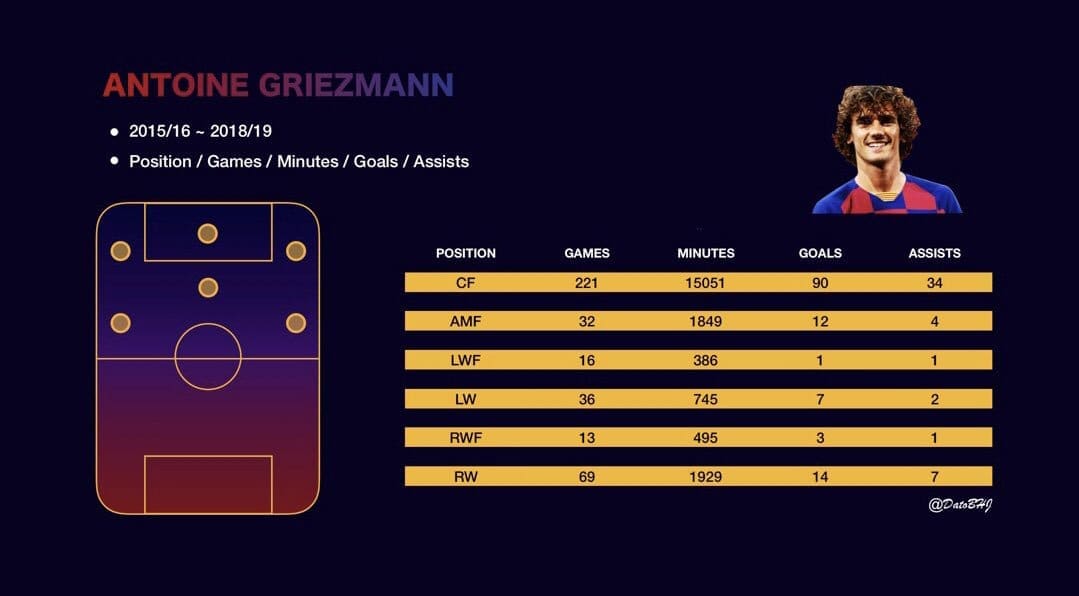
4-3-3/Left-wing
We’ll start with the most prominent and the most likely scenario to unfold, at least at the very beginning of the season. Valverde defaulting to a 4-3-3 is very much a given at this point and seeing how Suárez is unlikely to get benched right from the bat, the Basque coach will definitely try to play the trio of Messi, Suárez and Griezmann all in the same lineup.
If and when that happens, Griezmann will be relegated to the left-winger role, which is familiar but also not ideal for him. Sure, as we’ve seen in the last graphic, he has played a total of 36 games, scoring seven goals and assisting two while playing in that role but that’s still a far cry from his more preferred, centre-forward one.
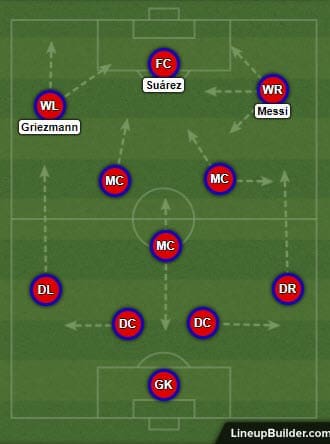
Above is the graphic for the respective lineup in its first and most likely version. Ousmane Dembélé would be benched in this case and we would have the aforementioned trio upfront. Griezmann did spend his Real Sociedad days as a winger, scoring 46 goals in 180 appearances playing there so a transition back to that role might not hurt him as much.
He does possess a dose of pace to provide the team with the additional width and could promptly cut inside to let Jordi Alba overlap. This also moves him away from Messi so the two don’t step on each other’s toes, which is probably Valverde’s biggest worry when it comes to incorporating the Frenchman into the squad.
Below, you can see Griezmann’s fairly average heatmap when playing as a left-winger. We can immediately see that he doesn’t spend as much time on the wide left as a natural winger would but instead likes to cut inside and occupy the left half-space instead. Not too dissimilar to Coutinho’s movements when deployed on the left.
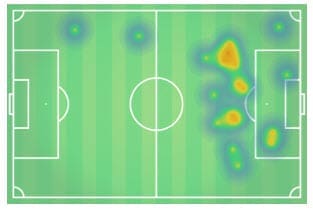
This would, in theory, give Barca a creator from both left and the right side while also enabling Jordi Alba to give enough width while attacking. We have already seen Griezmann hold the ball and give his team an additional creative spark when needed. He would drop a bit deeper to be able to receive it from either the midfield or the full-back and then hold it while he sets up a link for an overlap.
Notice in the example below how he does exactly that. This was taken from the game against Levante, in which Griezmann was playing as a left-winger but with a lot of positional freedom. He slots into his left half-space receives the ball and lays it off for the incoming teammate before drifting further into the middle.
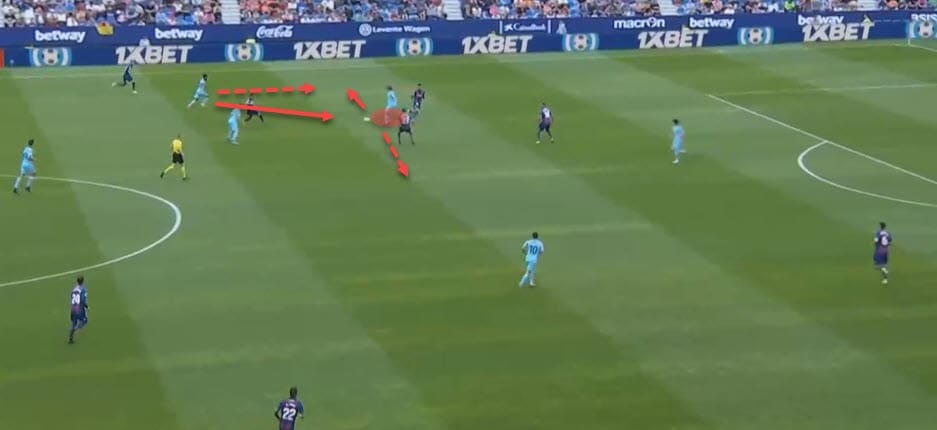
This emphasises a couple of things for Barcelona: a) Griezmann will most likely start from the wing but transition to a deeper, more central role in the build-up, leaving enough room for Alba to overlap and also add bodies into the midfield, and b) He probably won’t be limited to the left side exclusively, meaning that it’s likely he fills the vacated right side once Messi drifts into the middle.
We can support the second thesis with a quick look at Griezmann’s touches in the game against Levante (left) and Girona (right), both of which he played as a left-winger. The number of touches on either flank is almost equally dispersed while there are still more touches in the middle channels and the half-spaces.

Of course, there is also an alternative to this system, one in which Griezmann remains on the wing. Suárez is benched and in comes Ousmane Dembélé. In that scenario, Messi is deployed as a false nine and Dembélé as the right-winger, leaving Griezmann on the left but with a licence to drift into the position of a number nine when possible.
Notice in the graphic below how that looks on paper. Messi starts high and down the centre but the Argentinian would vacant his spot in order to drop deeper to a position of an attacking midfielder or a false nine, leaving the striker position to Griezmann.
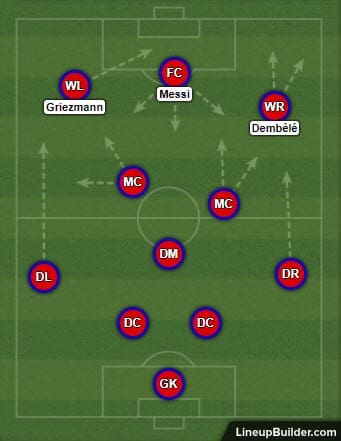
That way Griezmann cuts in from the left, Messi drops deeper to a more creative role, Alba can still overlap for width on the left and Dembélé forces the opposition wide on the right. In theory, this could work even better than the previous version since Suárez is a more static presence in the box and wouldn’t allow Griezmann that much freedom in the box. But in this scenario, he becomes the only central target-man, assuming the Uruguayan’s role.
And finally, two different aspects Griezmann’s presence should add to the overall Barcelona gameplay are defensive contributions and crossing, both of which are a rarity in the Catalans’ tactics. The Frenchman’s work-rate means that he will track back and run both ways regardless of his positioning on the pitch, which will give an additional dimension to the Blaugrana and will definitely be a sight for sore eyes considering Suárez and Messi are not known for their defensive contributions.
His crossing, however, is something Barca may not rely on but could come in handy in situations in which Griezmann does find himself out wide with Piqué and Lenglet storming the box. Last season, he averaged 1.5 crosses per game.
4-3-3/Centre-forward
The other, more popular version of a 4-3-3 system would definitely be with Antoine Griezmann in a centre-forward role, as Barcelona’s lone striker through the middle. In this scenario, Luis Suárez is once again benched, Ousmane Dembélé occupies the left wing and Messi starts from the right.
This is where Griezmann loves to be and this is where he excels the most. If we refer to our old chart for a moment, we can recall that he scored a total of 90 goals in 221 games as a centre-forward, assisting 34 in the process. But playing at Barca, he would definitely also have to transform into a more standard striker at times rather than exclusively assume his preferred false nine role.
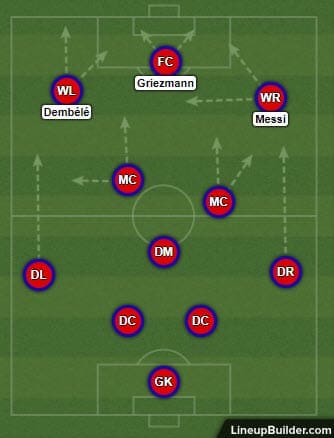
And this is where the problems with Messi might occur. Griezmann’s tendency to occupy the same positions on the pitch as Messi could be seen as a problem if the Frenchman is not converted into a more traditional type of striker; one that moves around the box rather than outside of it.
Sure, he can still link up with the midfield and drift to either wing if necessary, which would be welcomed since Messi usually leaves the right flank totally deserted. As long as he doesn’t step on Messi’s toes, it should all be well. Still, looking at his heatmap below, one could see why this might pose a problem
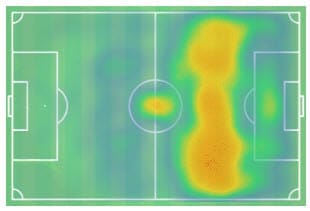
But seeing how Griezmann is excellent in transitions and has a lot more pace than Suárez, Barcelona can use him, alongside Dembélé, as counter-attacking presences that prevent the opposition from maintaining the high-press at all times, something the Catalans have extreme difficulty countering.
But adding Griezmann on the shoulder of the centre-backs with pace to burst into the space behind them should they leave any, and also making him constantly occupy them gives Barcelona a whole new dimension to play with. Add to this the fact that Frenkie de Jong is one of the most press-resistant midfielders on the planet and suddenly the Blaugrana become one scary machine to face.
Let’s analyse how that might look like on the pitch in two different scenarios. The first one depicts Griezmann staying high when his teammates are pushed back, giving them a chance for a swift break if the opportunity arises. Once his team regains possession, he can lose his marker using pace and fake runs and burst into space behind.
This keeps the opposition’s centre-backs occupied at all times and prevents them from completely pressing them since they have a forward practically living on their shoulder.
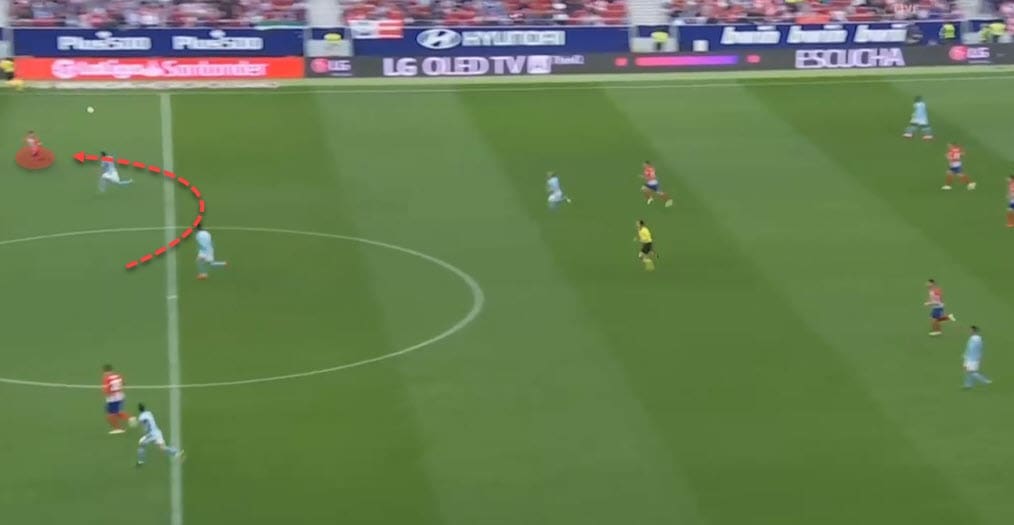
The same thing happened, poetically, against Barcelona. Griezmann was a constant threat because Barca send almost their entire squad forward, making themselves extremely vulnerable on the break. Griezmann moves exceptionally well once the transition is started.
He pulls his marker away, creating space for his teammates and attacking another pocket at the same time. This is something Suárez used to be great at but having 33 already on the back, he simply slowed down and isn’t able to sustain it for the whole 90+ minutes.
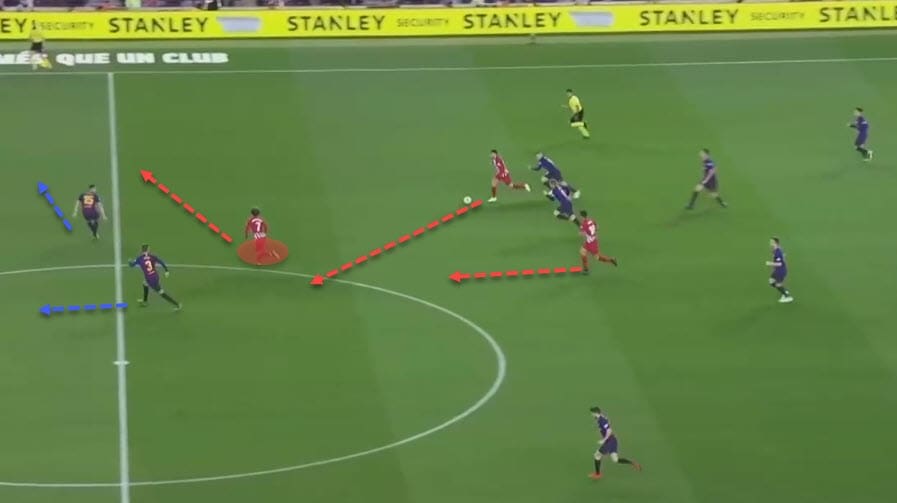
But of course, a Barcelona forward has to be able to communicate with his midfield and to bring others into play. We know how well he manipulates his markers and exploits or creates space and this is crucial compatibility with the Catalans’ tactics. Successfully dropping deeper so that Messi doesn’t have to or simply setting up Dembélé is already a much-needed addition to this team.
And the Frenchman is known for his creativity from deeper positions. Notice in the following images how that translates onto the pitch. In the first example, Griezmann drops just slightly to be able to receive the ball and grabs the attention of two markers. After getting the ball he quickly lays it off for the incoming teammate. If he can set up Dembélé or Messi like that, it could spell success for Barca.
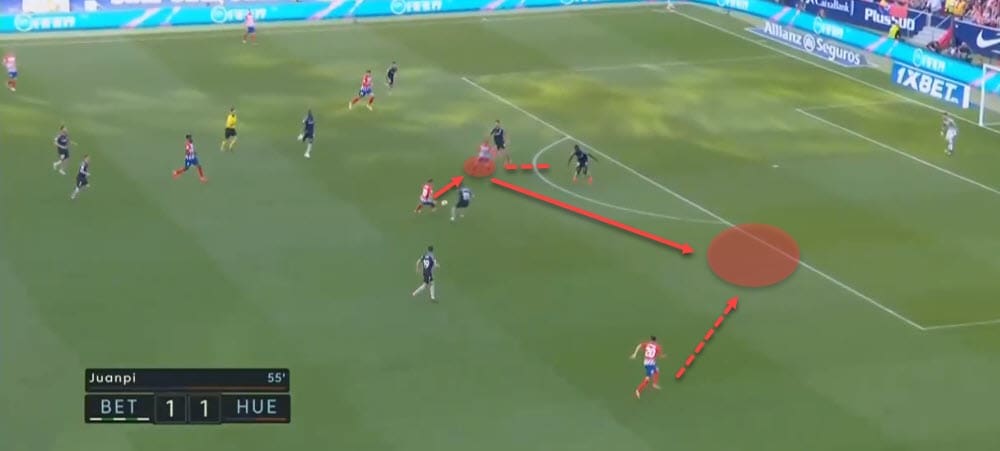
Another scenario might be Griezmann dropping all the way into the midfield, enabling Messi to constantly stay higher up the pitch where he is most dangerous. Below, Griezmann is around the middle of the park and he progresses the ball with a couple of quick touches before finally setting up a teammate with a fantastic through ball.
Of course, Messi and Griezmann could take turns and swap positions regularly since both are capable of fulfilling this role.
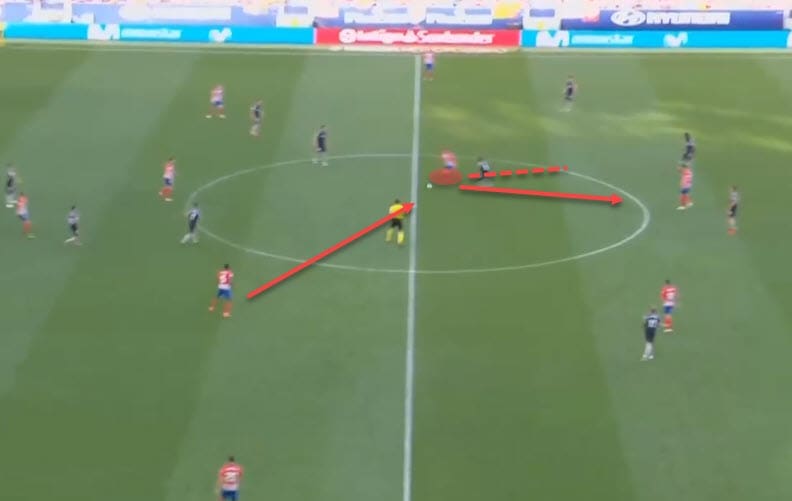
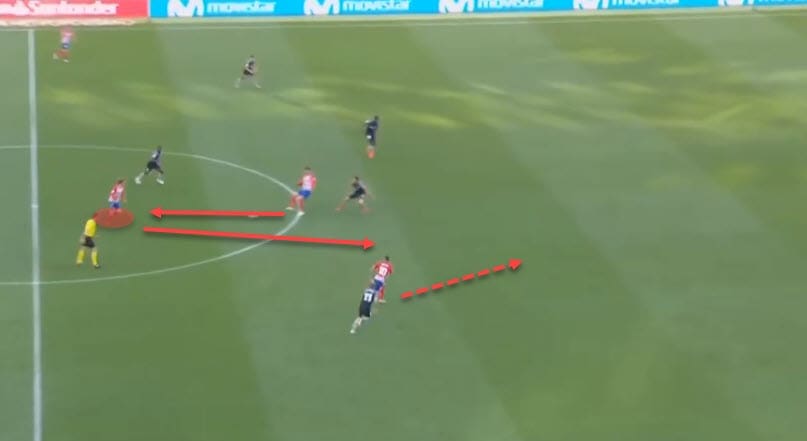
4-4-2/ 4-3-1-2/ 4-2-3-1
Valverde’s specialty, the 4-4-2 system he used to prefer, is actually the most akin to the tactics Diego Simeone deploys at Atlético Madrid. Griezmann spent the big majority of his Rojiblancos days as a slightly deeper positioned player in an attacking tandem upfront. In Barcelona, he would likely be the one higher up the pitch while Messi would assume the deeper position.

This would then require two wide midfielders to be deployed who can storm the flanks while a double-pivot is used in the middle of the park. Griezmann’s approach would also have to be slightly altered but his responsibilities would mostly remain the same as in the above section where he’s utilised as a centre-forward.
He would have to stay on the shoulder of the defenders, exploiting the space and giving Messi constant moving targets to find via his unbelievable passes. Of course, in the attacking phase this formation would turn more into a 4-2-3-1 with Griezmann upfront, Messi just behind him and then two wide midfielders manning the flanks.
It’s likely that the team would swap between those two systems depending on the situation on the pitch, rather than staying faithful to one exclusively. On paper, it does seem, however, that these are less likely to be actually used.
The same can be said for a slightly alternated version which would see Griezmann and Messi drop deeper behind Suárez, who would then be the lone striker. Once again, two wide men and two pivots would also have to be used in this scenario.
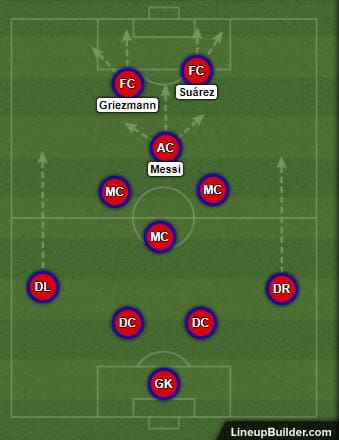
This does, however, leave the team extremely vulnerable with basically four attacking players and just two midfielders for cover, which is something Valverde should definitely keep an eye on.
Finally, there’s always an option to deploy the team in a 3-4-3 system but this seems extremely unlikely. In this formation, Griezman would be played in either of the two aforementioned roles that involve a front three and they would have a quartet of midfielders behind their backs.
Even though Barcelona have used these type of tactics from time to time, with their emphasis on the full-backs and a big tradition of playing a trident both in midfield and the front, this just seems like too big of a risk.
Both Alba and Roberto/ Semedo would have to be transformed into wingbacks while a centre-back trio would be deployed behind them. Attacking wise and for Griezmann, not much would change but it would definitely require a whole reshuffle of the squad and an adaptation of a system that’s not really a part of Barcelona’s regular arsenal.
Conclusion
We have gone through a couple of more prominent systems Barcelona might use to incorporate Antoine Griezmann into the team and have also analysed what exactly his roles in those respective positions would be.
A simple glance at Barcelona’s most used formations throughout the last season also suggests that the 4-3-3 will probably be the way to go. The Catalans opted for the 4-3-3 64% of the time and then used 4-4-2 as their second favourite with only 13%.

Initially, Griezmann will inevitably start as a winger but it remains to be seen whether Valverde decides to completely reset him to a winger or will he take over Suárez’s position somewhere along the line.
Either way, due to the sheer amount of quality the player possesses, this task should still very much be doable, and exciting, for the Ant.
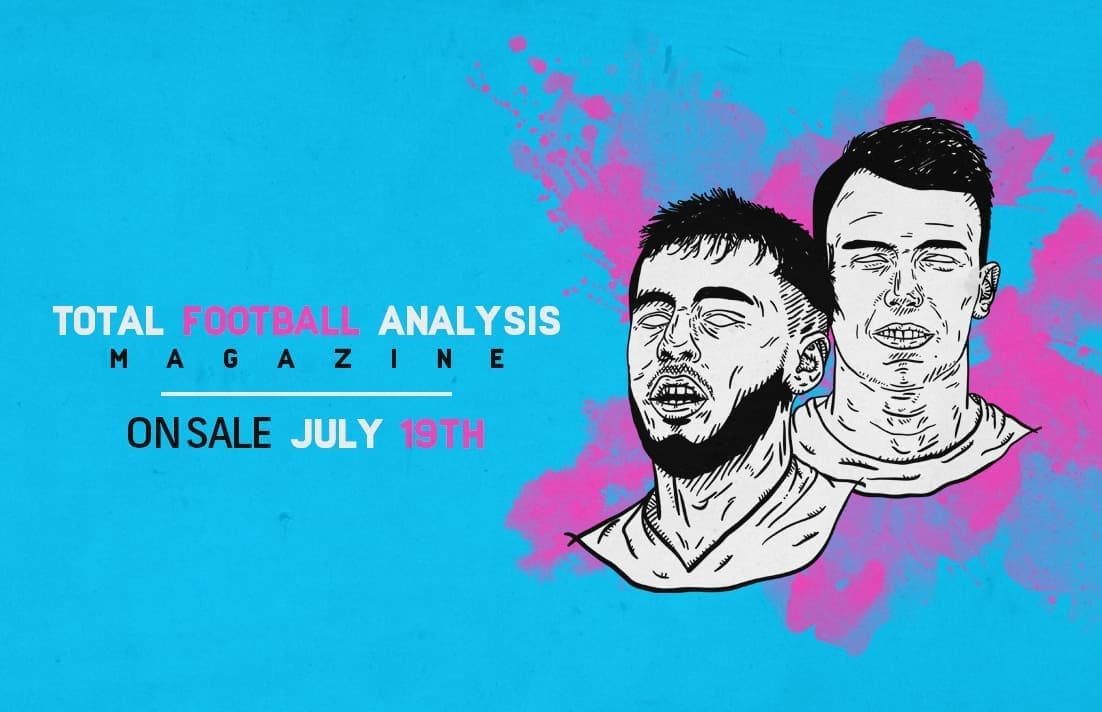
If you love tactical analysis, then you’ll love the digital magazines from totalfootballanalysis.com – a guaranteed 100+ pages of pure tactical analysis covering topics from the Premier League, Serie A, La Liga, Bundesliga and many, many more. Buy your copy of the July issue for just ₤4.99 here, or even better sign up for a ₤50 annual membership (12 monthly issues plus the annual review) right here.

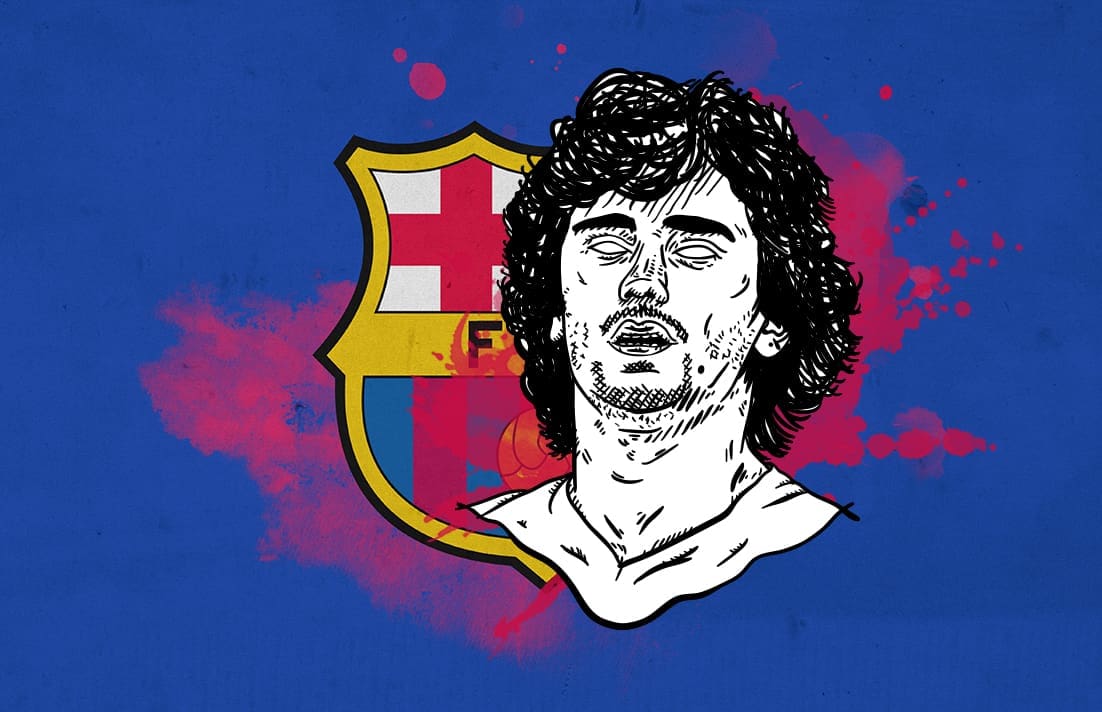




Comments